Ever thought about why Ragdoll cats are so big? It’s not just their beautiful fur and loving personality that make them stand out. It’s their size. They were first bred in the 1960s from a cat named Josephine. Ragdolls are one of the rare breeds that need up to 4 years to grow to their full size.
Ragdolls are often called “puppycats” for good reason. They can weigh between 10 and 20 pounds. They stand 9-11 inches tall and are 17-21 inches long without their long tails. These cats are huge but they’re very calm and friendly. This makes them great for living indoors with people.
Key Takeaways
- Ragdolls can weigh anywhere from 10 to 20 pounds.
- They grow slowly, reaching full size at around 4 years old.
- The breed stands 9-11 inches tall and can measure up to 21 inches long, not counting their tails.
- Ragdolls possess gentle and affectionate personalities.
- The breed originated from a partially feral cat named Josephine in the 1960s.
Introduction to Ragdoll Cats and Their Size
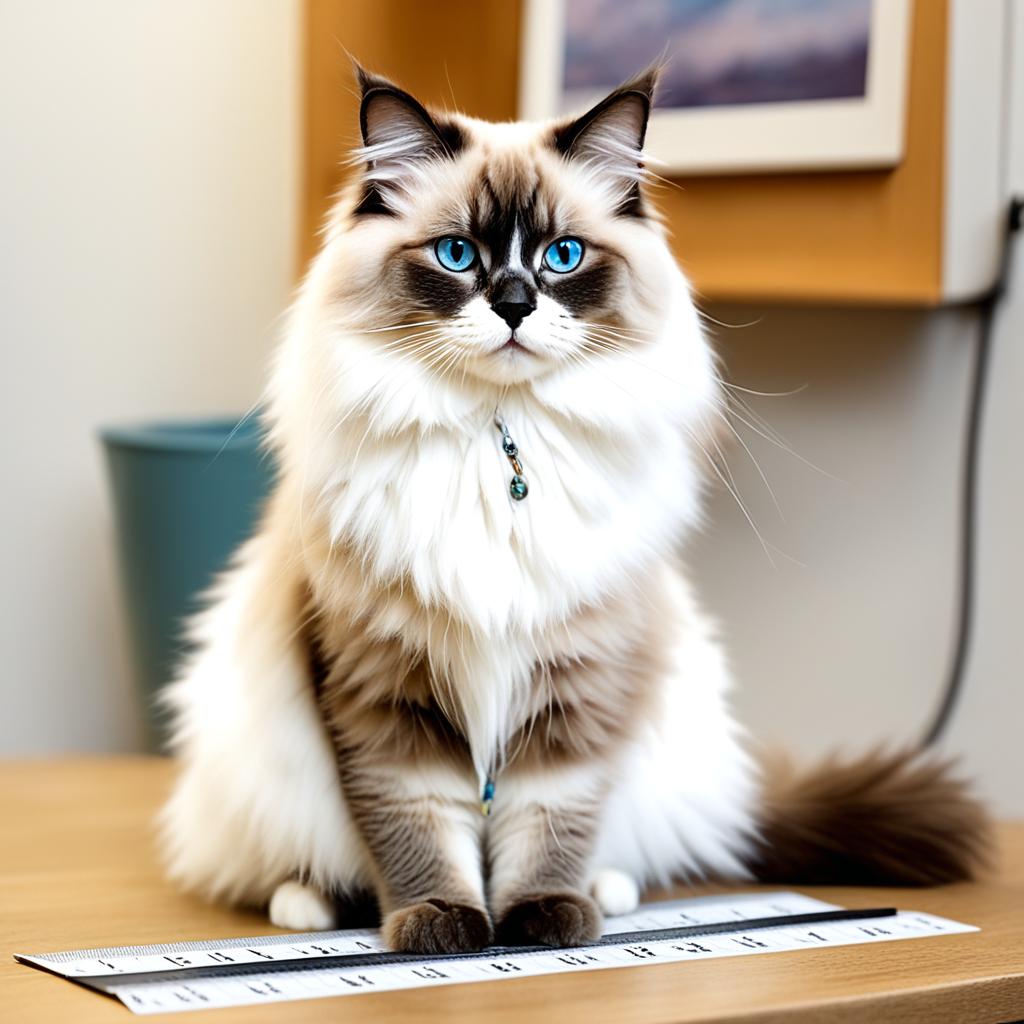
Ragdoll cats are known for their soft fur and piercing blue eyes. They have a rich history and impressive size. We will look at how they came to be, their special features, and friendly personality.
History of the Ragdoll Breed
In the 1960s, a breeder named Ann Baker started the Ragdoll breed in Riverside, California. She found a special cat named Josephine, and her kittens had extraordinary qualities. This marked the beginning of the Ragdoll line. Breeding them for their size, gentleness, and beautiful eyes, she developed the Ragdoll cat we know today.
Distinctive Appearance and Coat
A Ragdoll cat’s soft, silky fur and captivating eyes immediately catch your attention. Their eyes are mainly blue but can be different colors. They come in many coat patterns, like colorpoint and mitted. This variety makes Ragdolls even more attractive.
Temperament and Behavior
Ragdolls are not just about their looks; their personalities are also charming. They are very calm and love to be around people. You might wonder how big they can grow, and they do get pretty large. Yet, they are always sweet and friendly. They prefer relaxing with their human friends to lots of playing, which makes them perfect for calm homes.
Understanding Ragdoll Cat Growth and Development
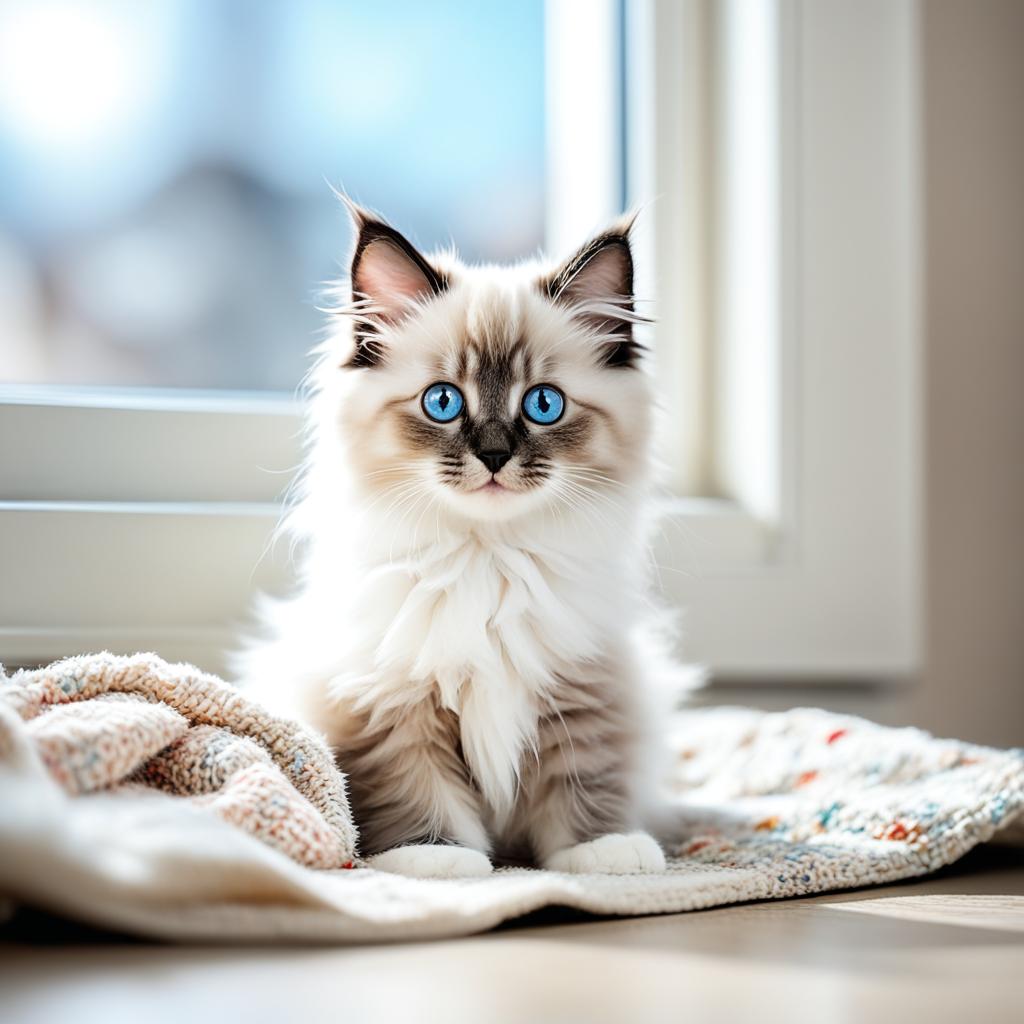
The journey from a small kitten to a big, beautiful Ragdoll cat is truly incredible. It’s important to know the stages, timeline, and key factors in their growth.
Growth Stages from Kitten to Adult
Ragdoll cats grow in clear stages, including:
- Kittenhood (0-6 months): At the start, they grow very fast.
- Adolescence (6-18 months): Their growth slows down, but they add more size and weight.
- Young adulthood (18 months-4 years): This is when they reach their full adult size.
When Do Ragdoll Cats Stop Growing?
Ragdoll cats don’t mature as quickly as some other breeds. They usually stop growing completely when they are four. During these years, watching them grow is a lesson in patience.
Factors Affecting Ragdoll Cat Growth
Several key things can affect a Ragdoll cat’s growth. These include:
- Genetics: Your cat’s genes mostly decide how big they’ll get.
- Nutrition: A well-balanced diet is essential for their growth.
- Spaying/Neutering: Getting them fixed early can impact their growth and size.
Making sure they get the right nutrients at every stage is key to their healthy growth. With this knowledge, you’re ready to help your Ragdoll cat grow into a strong and healthy adult.
Average Size and Weight of Ragdoll Cats
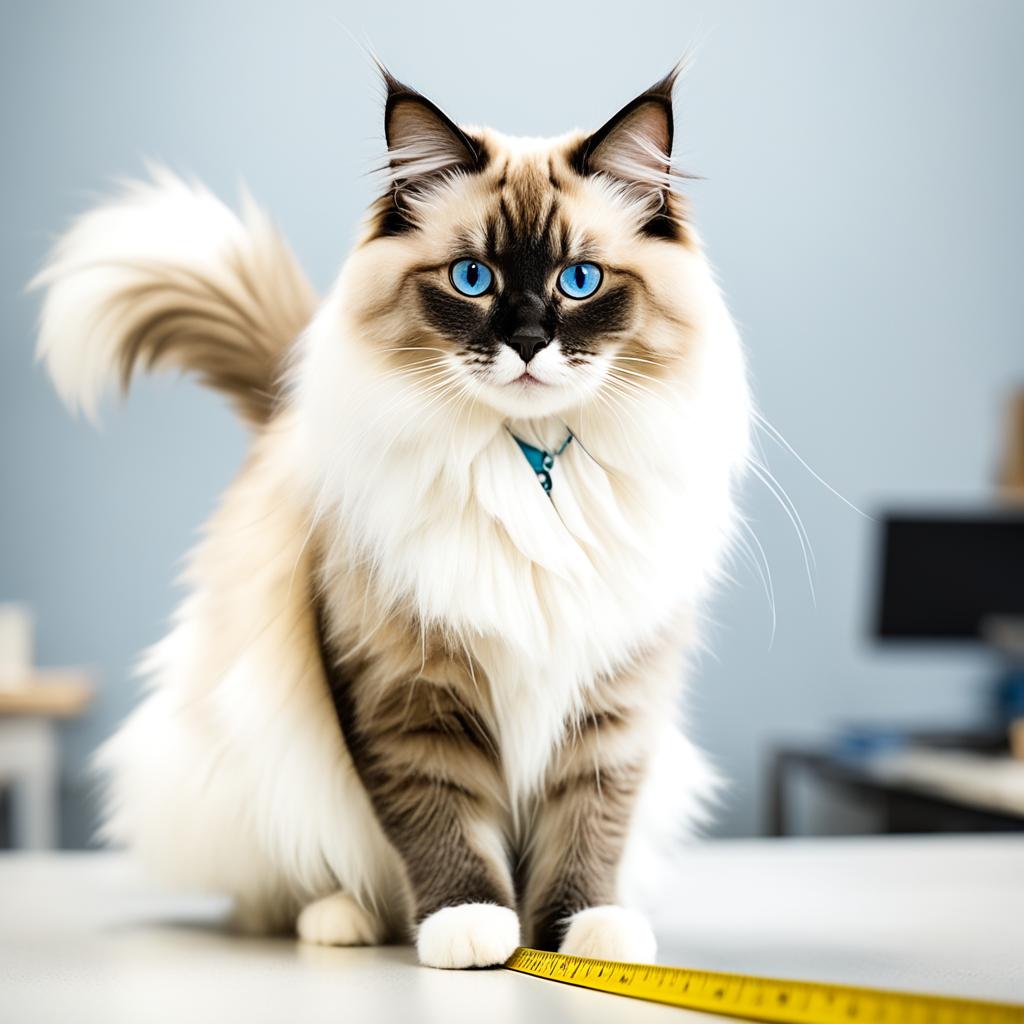
Ragdoll cats are truly majestic, known for their large size and gentle personalities. The Ragdoll Cat Average Size falls between 10 to 20 pounds. Females can be just as big as the males. Their height at the shoulders is 9 to 11 inches.
These cats are not just big; they are also incredibly affectionate and friendly. Their bodies are 17 to 21 inches long. Add their fluffy tails, and they become even more impressive.
Despite their size, Ragdolls are big-hearted and known for their loving nature. So, don’t let their big size scare you off. They are gentle giants.
| Size Aspect | Measurement |
|---|---|
| Average Weight | 10 – 20 lbs |
| Height | 9 – 11 inches |
| Body Length | 17 – 21 inches |
Thinking about getting a Ragdoll cat? Make sure you have plenty of space. They will fill your home with their love and charm.
How Big Can a Ragdoll Cat Get?
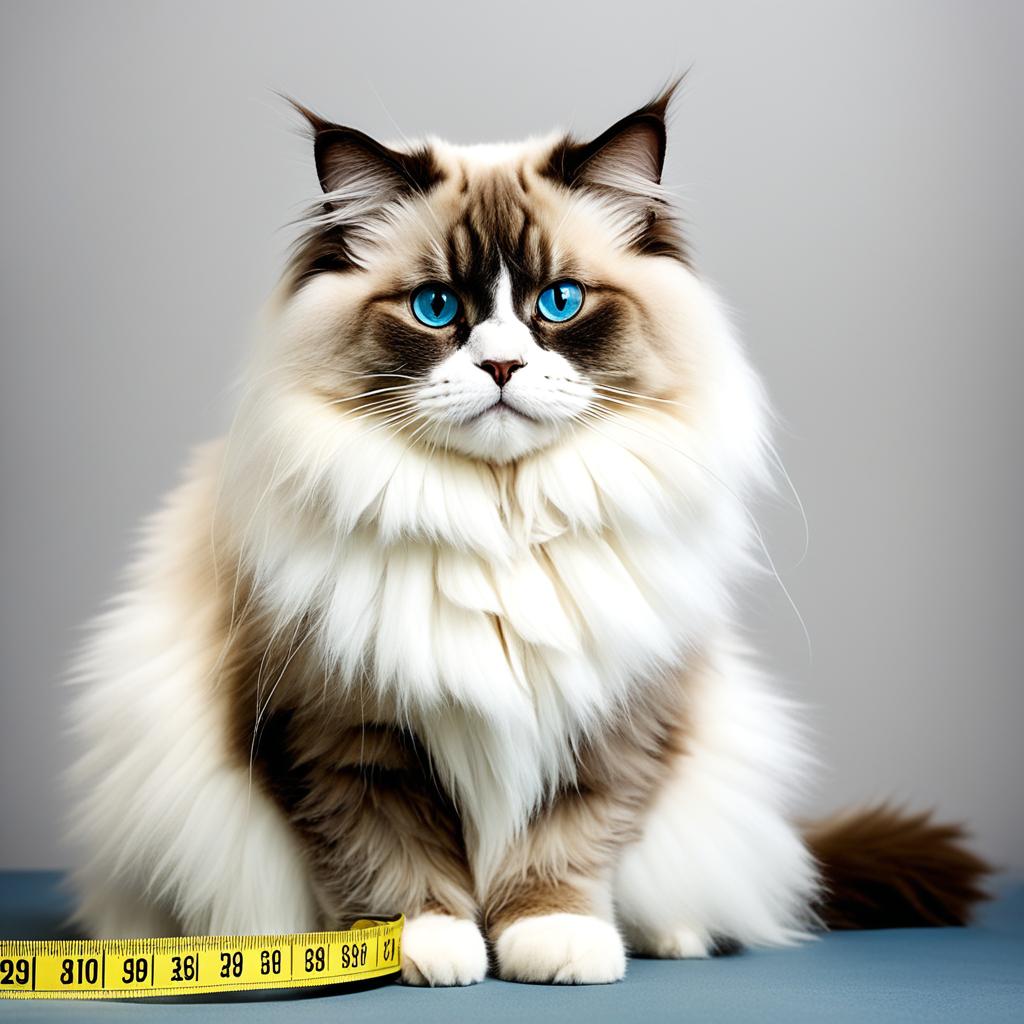
Ragdoll cats often amaze their owners with their large size. They are known for being both big and gentle. This makes them unique among pets.
Comparisons with Other Large Cat Breeds
Wondering how Ragdolls compare to other big cat breeds? Ragdolls are similar in size to Maine Coons and Savannah cats. Yet, their calm nature stands out. Maine Coons are also large but more active. Savannahs bring a bit of the wild to their size. If you want a large, loving cat, Ragdolls are a good choice.
Genetics and Size Potential
The size of a Ragdoll Cat comes from its genetic background. The work started by Ann Baker in the 1960s has led to their current size. A good diet and exercise also play a big role. It helps Ragdolls grow to their full, impressive size.
Surprising Facts About Ragdoll Size
One might think that very large cats would be less active. Yet, Ragdolls are quite hearty despite their size. They can grow over 40 inches long, but are agile due to their heavy bones. This makes them a surprising mix of strength and softness.
Male vs. Female Ragdoll Cat Size
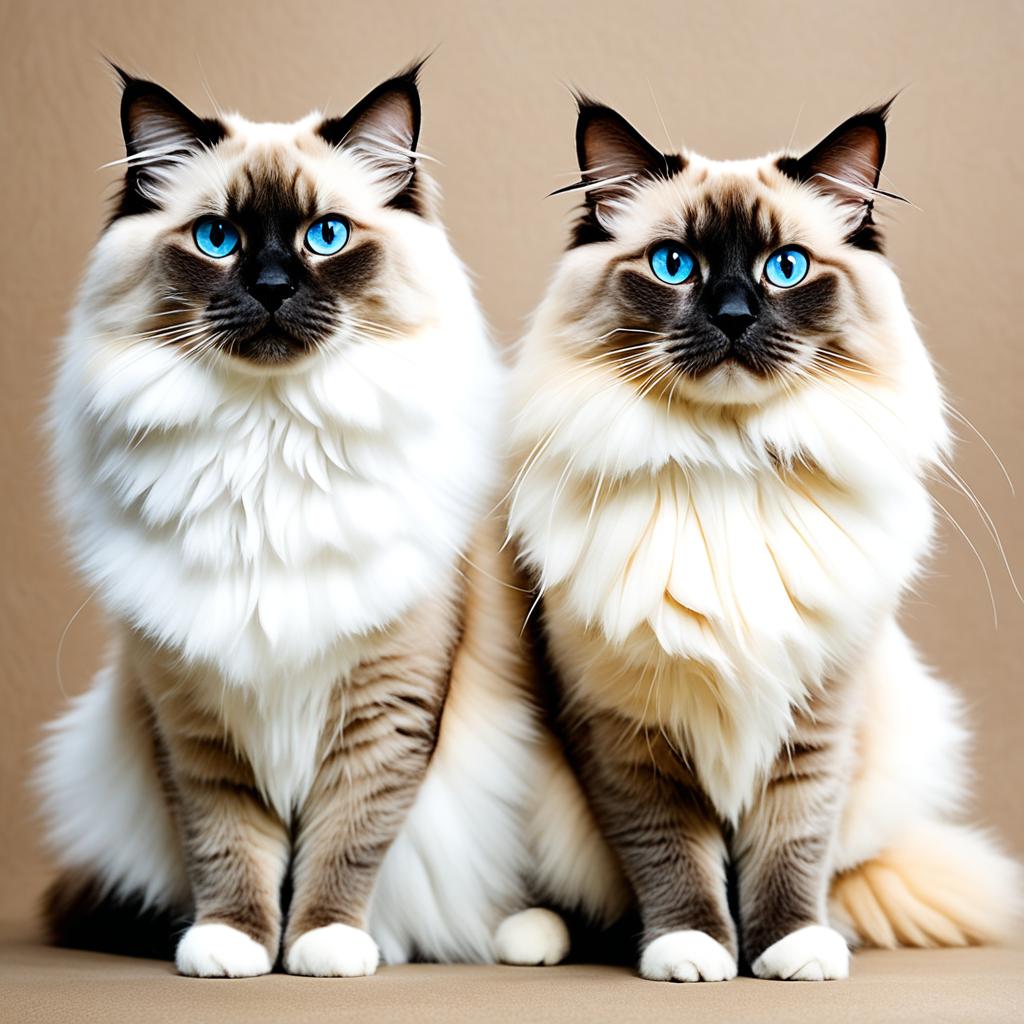
Male and female Ragdoll cats have distinct sizes. Even though they both can be quite large, there are key differences. Male Ragdolls are usually bigger. They can weigh up to 20 pounds. This is much heavier than your average house cat. On the flip side, female Ragdolls are a bit smaller, about 15-25% across all measurements. But they still keep that known Ragdoll size.
Size Differences Due to Gender
Male Ragdolls are the big boys of the Ragdoll world. They can reach weights of up to 20 pounds. This is quite a lot when you compare it to other cat breeds. However, female Ragdolls are a bit smaller. They’re about 15-25% tinier. But even so, they keep that large size that Ragdolls are famous for.
Average Weight and Dimensions
| Gender | Weight Range (lbs) | Height (inches) | Length (excluding tail) |
|---|---|---|---|
| Male | 15-20 | 9-11 | 17-21 |
| Female | 10-15 | 8-10.5 | 14-18 |
Knowing these sizes will help you get ready for your Ragdoll. Whether you like the hefty male Ragdoll or the slightly smaller female Ragdoll, both have the same loving and calm nature. This is what makes the Ragdoll breed so special.
Ragdoll Cat Diet and Nutrition for Optimal Growth

Ensuring your Ragdoll cat gets the right food and nutrients is key for their health. This is important for their growth and overall well-being.
Ideal Diet During Kittenhood
Start the right diet for your Ragdoll cat when they are a kitten. Use high-quality foods made for kittens. These foods help them grow well and stay healthy.
Maintaining a Healthy Adult Weight
Keeping your Ragdoll at a healthy weight is crucial as they grow. A good diet for adult Ragdolls is low in carbs and free from fillers. It should be full of good protein and fats to keep them strong but slim.
Foods to Avoid for Ragdoll Cats
Be careful about what foods you give your cat to protect their health. Avoid carbs, artificial additives, and fillers like corn and soy. These can lead to weight problems and bad health.
| Life Stage | Recommended Diet | Foods to Avoid |
|---|---|---|
| Kitten | High-quality kitten food rich in animal protein | Low-quality fillers, artificial additives |
| Adult | Balanced diet with minimal carbs, high protein | Foods high in sugar and carbohydrates |
Preventing Obesity in Ragdoll Cats
It’s vital to keep Obesity in Ragdoll Cats at bay for their health. This is done through proper diet and exercise. Like other indoor cats, Ragdolls need playtime to stay active. It also taps into their hunting instincts.
Begin with high-quality food. This means more meat and less fillers to avoid weight issues. Controlling how much your cat eats is just as important for their health. Use a measured amount of food and stick to a feeding schedule. This stops them from eating too much.
- High-quality, meat-based diet
- Regular physical activity
- Controlled portion sizes
Don’t forget vet visits. They are great for keeping track of your cat’s weight and making diet changes. With these strategies, you can lower the chance of Obesity in Ragdoll Cats. This keeps them as the lively friends we love.
| Prevention Tips | Benefits |
|---|---|
| High-quality diet | Ensures proper nutrition |
| Regular exercise | Burns excess calories |
| Portion control | Prevents overeating |
| Vet check-ups | Monitors overall health |
Common Health Issues Related to Size
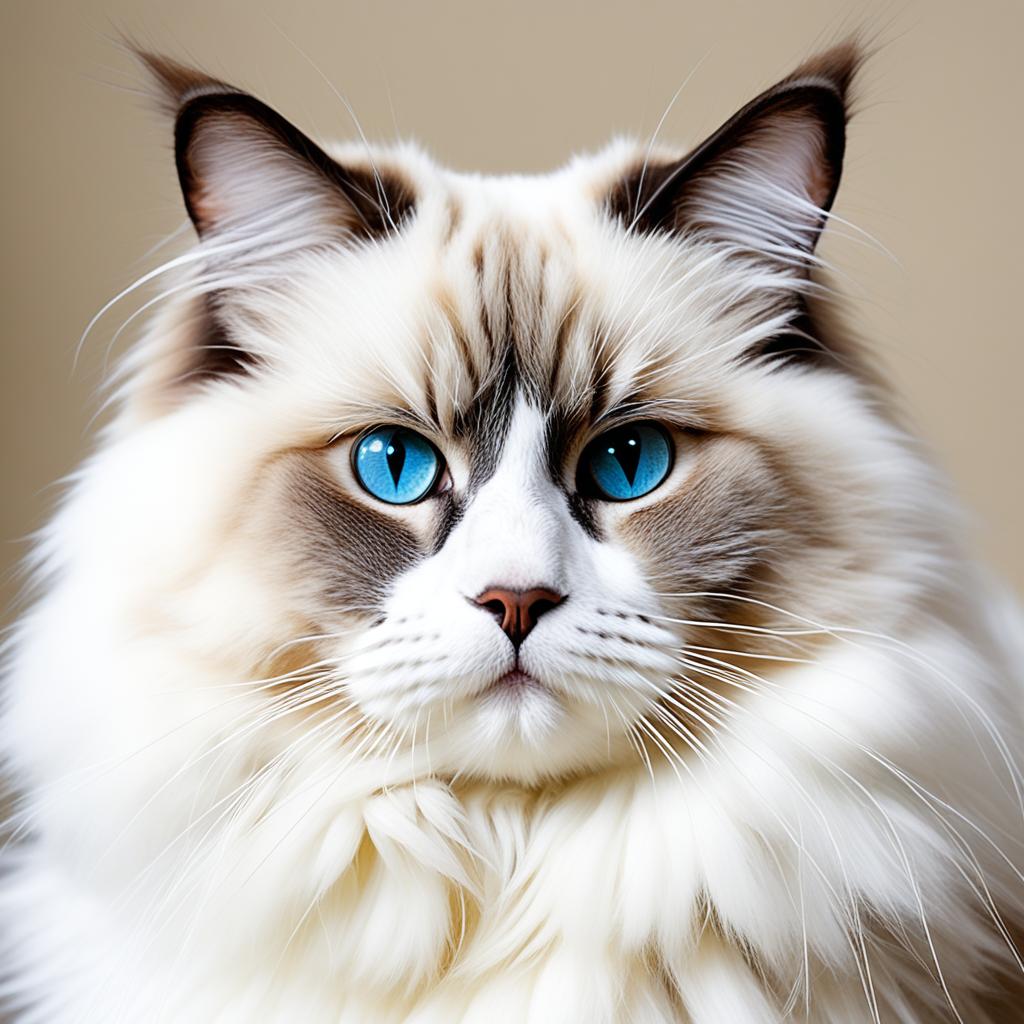
Large Ragdoll cats often face health issues. Keeping them healthy improves their life. It’s important for their well-being.
Skeletal and Mobility Concerns
Ragdolls can have problems with their bones due to their size. They might develop joint issues and hip dysplasia. This gets worse when they’re overweight. A healthy diet helps them move without pain.
Digestive Health and Weight Management
What a Ragdoll eats is key to keeping fit. A balanced diet fights obesity. It also boosts their energy. This keeps them lively and not lazy.
Regular Vet Checkups and Monitoring
Seeing the vet often is crucial. It helps spot health problems early. This means better care for their bones and mobility.
| Health Concern | Description | Prevention/Dietary Care |
|---|---|---|
| Hip Dysplasia | A genetic condition affecting joint formation | Maintain healthy weight, provide joint supplements |
| Arthritis | Chronic joint inflammation | Regular exercise, balanced diet rich in omega-3 |
| Obesity | Excess body fat leading to mobility issues | Controlled feeding, avoid high-calorie treats |
| Digestive Problems | Issues like constipation or diarrhea | High-fiber diet, adequate hydration |
How to Measure Your Ragdoll Cat’s Size Correctly

Ever wanted to measure your Ragdoll’s size accurately? You’re among many who do. They’re big, lovely cats. For proper growth tracking and good health, follow our easy guide.
Tools Needed for Accurate Measurements
Getting the right size measurements begins with tools:
- Baby scale for precise weight measurement
- Measuring tape for length and height
- Notepad and pen for recording measurements
Step-by-Step Guide to Measuring Weight
Measuring your Ragdoll’s weight right is key. Here’s what you do:
- Set up the baby scale on a firm, level surface.
- Take your cat’s weight when they’re calm and not moving.
- Write down the weight immediately to be precise.
Length and Height Measurement Tips
Finding out how long and tall your Ragdoll is takes careful work. Use these steps:
- Length: Measure from the tip of the nose to the base of the tail. The tail doesn’t count.
- Height: Measure from the top of the shoulders to the bottom of the paws.
- Tail Length: Measure the tail from the base to the tip.
Regular size checks let you watch your Ragdoll’s progress. They also hint if something’s not right with your cat’s health.
Keep track with consistent notes and watch for changes with the Ragdoll Cat Measurement Guide.
Comparison with Other Domestic Cat Breeds

Ragdoll cats are truly big compared to other domestic breeds. This domestic cat breed comparison shows their massive weight and unique qualities. Knowing these differences helps us see what makes Ragdolls special.
Size and Weight Differences
Ragdolls are some of the largest domestic cats around. Most cats weigh 8 to 10 pounds. But a Ragdoll can weigh as much as 20 pounds. They also have long tails, adding to their size.
Typical Characteristics of Domestic Cats
In a detailed domestic cat breed comparison, you notice the Ragdoll’s unique traits. Ragdolls are not like other breeds. They are very calm and loving. People often call them “puppycats” because they relax completely when you hold them.
| Breed | Average Weight (lbs) | Notable Traits |
|---|---|---|
| Ragdoll | 10-20 | Affectionate, calm, dog-like |
| Siamese | 6-14 | Active, vocal, social |
| Maine Coon | 10-25 | Intelligent, gentle giants |
| British Shorthair | 7-17 | Easy-going, quiet |
| Bengal | 8-15 | Energetic, playful |
In terms of size, Ragdolls are giants in the cat world. Their friendly and loving nature makes them even more special. This makes them a top choice for those wanting a big-hearted friend.
Conclusion
Learning about Ragdoll cats is important because they have unique needs. Their size, diet, and health are different from other cats. They are big and very loving. By understanding these needs, you create a happy life with your new cat.
Taking care of your Ragdoll’s health is key. Take them for regular checkups. Watch their diet and weight closely as they grow. This way, you can spot health issues early. Use the advice in this guide to keep your Ragdoll cat happy and healthy.
Ragdolls are a joy to have at home. They need a lot of care and love. Keep an eye on their growth and what they eat. This is how you make sure they are happy and live a long life. With good care, a Ragdoll will bring lots of love and warmth into your home.




